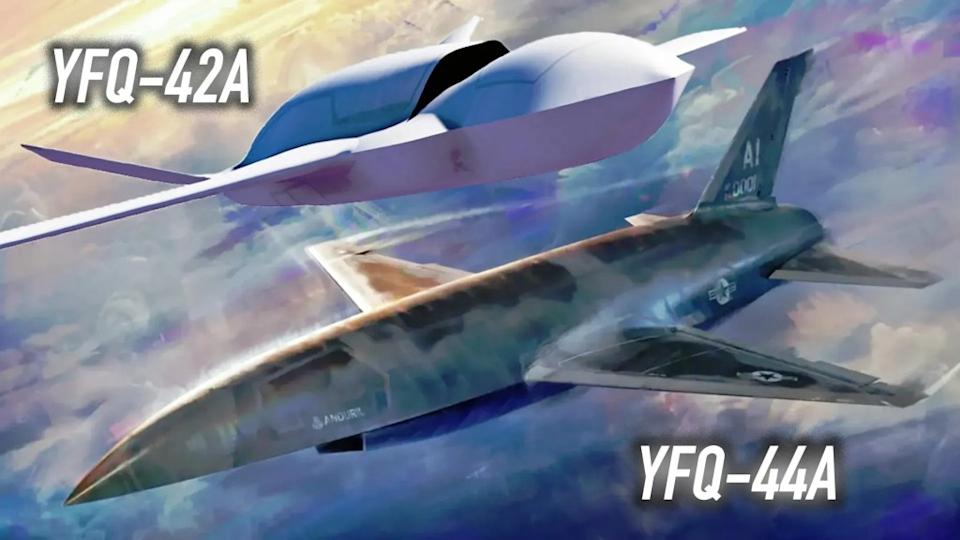Exploring Air-Launching Collaborative Combat Aircraft (CCAs)
The U.S. Air Force is actively exploring the concept of air-launching Collaborative Combat Aircraft (CCA) drones from various aircraft, seeking to minimize reliance on traditional runways. This strategy aligns with the broader vision of CCAs, which are intended to have a significant impact on the dynamics of aerial combat and to pose new challenges for adversaries. However, launching CCAs from carrier aircraft introduces its own operational challenges that will need to be addressed.
Procuring Air-Launched CCAs
Air Force Maj. Gen. Joseph Kunkel highlighted the potential procurement of air-launched CCAs during a May 8 virtual talk hosted by the Air & Space Forces Association’s Mitchell Institute for Aerospace Studies. Kunkel, the Director of Force Design, Integration, and Wargaming at the Pentagon, emphasized the necessity of advancing the Air Force’s CCA program through iterative development phases.
Development Cycles and Designations
The Air Force’s approach to the CCA program is characterized by a series of iterative development cycles. Companies like General Atomics and Anduril are developing drones that have recently been designated as YFQ-42A and YFQ-44A, respectively, forming part of the program’s initial phase, Increment 1. The requirements for the succeeding Increment 2 are nearing finalization, with indications that the Air Force may favor lower-cost and less complex designs for this round of procurement.
Strategic Considerations for Combat Power Generation
Maj. Gen. Kunkel remarked on the importance of generating combat power from a variety of deployment sites. He mentioned that employing shorter or vertical takeoff capabilities could significantly enhance operational flexibility. However, these design choices may lead to trade-offs in payload and range, underscoring the complexity involved in balancing these aspects when considering CCAs.
Moving Away from Ground-Based Operations
Kunkel suggested that the Air Force is considering alternatives to launching CCAs from the ground. Instead, the idea of deploying CCAs by air-dropping them from aircraft is on the table. This concept supports the goal of diminishing reliance on fixed airbases for operations, thereby enhancing tactical flexibility.
Engineering for Agile Combat Employment
While the YFQ-42A and YFQ-44A are designed for standard runway operations, they are also being developed to align with the Air Force’s Agile Combat Employment (ACE) framework. ACE emphasizes the importance of deploying forces in unconventional ways across a dispersed array of operating sites, including those with limited infrastructure. This agility is intended to complicate enemy targeting efforts and reduce vulnerability.
The Importance of Runway Independence
The operational advantages of CCAs that can function independently of traditional runways are significant. Such capabilities would facilitate launching and recovering from a wider array of locations, increasing operational unpredictability for adversaries. CCAs that can effectively operate from remote, less secure environments stand to mitigate the risks associated with concentrated air operations.
Survival and Evasion Strategies
Air Force officials recognize the necessity of maintaining operational capabilities even under enemy attacks. This is particularly relevant in potential high-stakes scenarios like a confrontation with China in the Pacific region. Given historical developments in enemy missile technology, the need for CCAs to operate from varied, inconspicuous locations becomes even more pertinent in deterring adversarial targeting.
Enhancing Combat Complexity for Adversaries
Kunkel noted that increasing the operational complexity for adversaries is essential for future air superiority. CCAs could deliver affordable mass and contribute to operational unpredictability, thus keeping opponents uncertain about the U.S. military’s intentions and capabilities. The ability to employ CCAs effectively could force adversaries to reconsider their strategies and threat assessments.
Air-Launching Strategies and Multi-Directional Engagements
Deploying CCAs via air-launching can further complicate engagement scenarios for adversaries, who could be faced with threats emerging from multiple directions simultaneously. Should air-launched CCAs diverge from their primary unit to engage targets, this creates additional layers of tactical difficulty for enemy operations.
Supporting Vulnerable Assets
In scenarios that require protecting high-value assets, air-launched CCAs can provide crucial support. Operating from less vulnerable positions allows CCAs to engage threats in more contested environments, which could be particularly useful for defending vulnerable assets like AWACS and tanker aircraft, especially when time-sensitive threats are detected.
Integration with Next-Generation Platforms
Future platforms like the B-21 Raider bomber may extend the operational range of CCAs by launching them from within contested airspace. The Pentagon is currently examining how these advanced drones can effectively coordinate with manned aircraft to enhance both offensive and defensive mission capabilities.
Collaboration with Other Branches
The Air Force is also working closely with the Navy and Marine Corps to establish a common architecture for CCAs. This collaboration is aimed at ensuring seamless operational control across different military branches, enhancing overall responsiveness in the face of evolving threats.
Challenges Ahead for Recovery and Refueling
As the concept of air-launched CCAs develops, operational considerations regarding recovery methods and mid-air refueling will remain critical. Addressing these logistical challenges is vital, particularly if operations necessitate recovery from high-risk or contested environments. Managing range limitations to maintain mission flexibility will be a key aspect of operational planning.
Considering Cost-Effective Solutions
Exploring the use of expendable or optionally recoverable air-launched CCAs could provide an additional tactical edge, provided that these systems are manufactured at low cost. Concepts for consumable drones capable of undertaking high-risk missions while remaining effective are still in the conversation, with the potential for rapid deployment enhancing operational efficacy.
Conclusion
In summary, the Air Force’s exploration of air-launched CCAs represents a significant shift in combat strategy, aimed at creating operational dilemmas for adversaries and enhancing overall adaptability. As the program evolves, a focus on streamlining design, improving inter-service collaboration, and balancing costs will be necessary for realizing the full potential of these systems in future conflicts.



